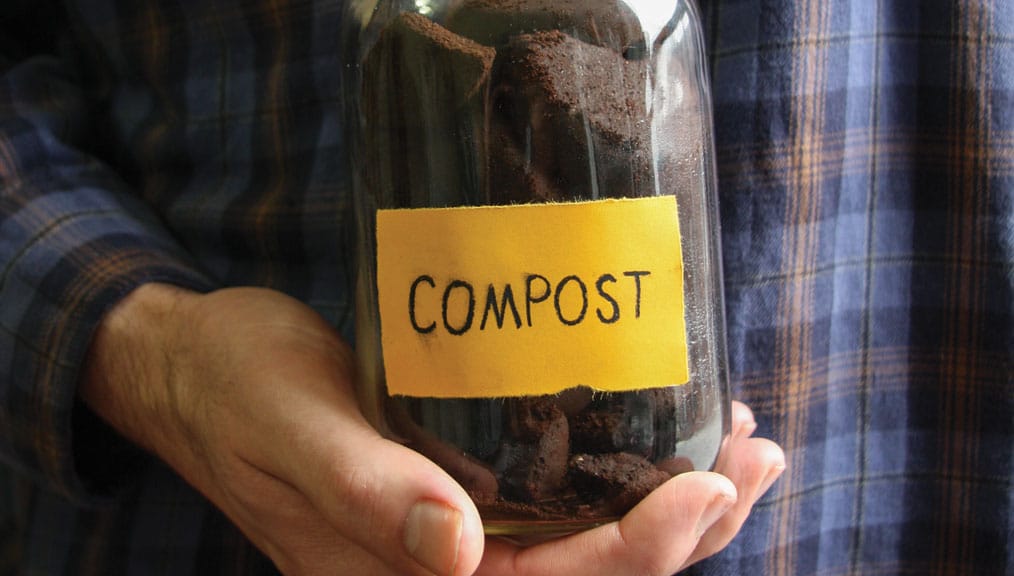(Photo: Cynthia Meadors.)
[W]hen two Austin, Texas, coffee shops decided to become part of Austin-based Compost Coalition’s Ground to Ground program, their participation perked up benefits beyond making their neighborhood a little greener.
Connecting coffee shops with local residents, the Ground to Ground program helps coffeehouses and similar businesses share used coffee grounds with visitors. Along with encouraging participants to drop off these used grounds at community gardens, parks, or agricultural organizations, they’re available for personal use—all in an effort to make Austin’s soils greener.
A Boost from Social Media
Victor Levi, owner of Genuine Joe Coffeehouse in Austin, says participating in a program like Ground to Ground can complement existing marketing efforts.
When Levi first opened Genuine Joe, he relied heavily on face-to-face marketing. He says he traveled “door-to-door in the neighborhood, and that was our advertising.” Participating in Ground to Ground has allowed his shop to take advantage of word-of-mouth advertising, a highly valued information source for Austin residents.
The Ground to Ground website also lists participating shops, so consumers can easily see which cafés offer spent coffee grounds.
“Ground to Ground has been very good. They put out social media posts letting people know Genuine Joe has fresh coffee buckets, so you get that advertising and promotion,” Levi says.
In addition to social media posts to notify customers when buckets are full and ready for pick-up, followers also see when empty buckets come in, so they can anticipate more grounds. “It gives people a little update like, ‘next week you should be able to get grounds,’” Levi says.
A Seamless Blend
Texas Coffee Traders (TCT) also participates in Ground to Ground through their Austin retail shop. Operations manager Traci Armstrong says the program works seamlessly with their retail goals.
“We always have one of the buckets in our retail area by our coffee and espresso-brewing station [and] fill it up daily with spent coffee grinds,” she says. Customers come in to pick up full buckets, exchanging them with empties. TCT has used this model for more than three years. “I would say we probably go through four or five of the five-gallon buckets a week with the Ground to Ground program.”
Before joining the Ground to Ground network, Texas Coffee Traders worked with a different local company to recycle much of their waste. Armstrong says they like that partnering with Ground to Ground still offers an avenue to recycle coffee waste, but with the benefit of developing lasting relationships with customers.
Turning Visitors Into Regular Customers
Working with Ground to Ground displays TCT company values, and the partnership has helped retain customers visiting for the first time. New customers are guided through each of the day’s brewed coffees; if there’s time, a facility tour is also offered.
The twenty-minute tour consists of “Coffee 101,” as Armstrong explains. The first stop: a wall map featuring photographs of coffee in progressive stages of growth and production. From there, tour participants see the warehouse facility where green coffee is stored, and receive an explanation of the coffee roasting process and the company’s ongoing sustainability efforts. During the warehousing and sustainability discussion, participants learn how the shop participates in Ground to Ground.
Armstrong says creating memorable first-time experiences helps develop repeat customers; the Ground to Ground partnership is an important element of the experience.
Reduced Waste Removal
When TCT began working with Ground to Ground, they had four, fifty-gallon drums of coffee-grind waste at their facility. After full participation in the program, she says, “now we usually average two or three compost drums, and I do think a lot of that has to do with people in the community coming to pick up the five-gallon buckets of grinds instead of us having to put them into our larger compost bins.”
Though the noticeable savings in waste disposal costs is nice, Armstrong credits the mission’s greater benefit.
“For us, it’s not necessarily about saving money,” she says. “It’s more about getting people to reuse coffee grinds; we’d much rather them get reused and not go into a landfill.”
Though Ground to Ground serves the Austin area, many similar programs exist to serve other communities. The ability to repurpose coffee grounds is reason enough to participate, but partnering with community organizations offers tangential benefits in marketing, customer retention, and operational savings.
—Thomas Hill is a Connecticut-based freelance writer.















